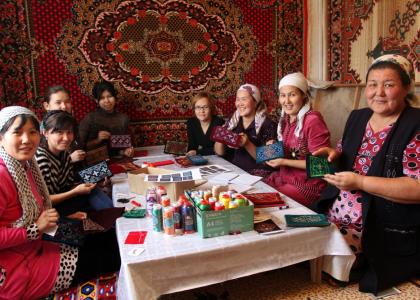Kuralai Saiga Craft Embroidery Project

The Kuralai Alternative Livelihood project in Uzbekistan celebrates local women who are creating beautiful traditionally embroidered bags to help save saigas.
Kuralai means ‘Baby Saiga’ in Uzbek. The Kuralai embroidery project empowers women in the region, offering them training and support and enabling them to have an alternative source of income.
In remote regions of Uzbekistan high unemployment and few job opportunities mean that poaching saiga for their meat and horn can become an attractive option. With saiga meat a cheap option in local markets, women will often buy saiga meat instead of beef or mutton. Saiga horns are also known as ling yang (羚羊) and used in Traditional Chinese Medicine.
Our embroidery projects give women the opportunity to learn new skills in sewing as well as business and marketing, ensuring this enterprise continues in the long-term. The potential to earn a sustainable wage and provide a consistent income to the family home will enable women to purchase more expensive meat, hence stopping the demand for saiga poaching.
Combining embroidery and business training with information on saiga conservation means that the women act as multipliers of the conservation message and deter male family members from becoming poachers.
Saiga Near the Embroidery Project
The population of saiga antelope in the Ustyurt region at present amounts to no more than seven percent of its form size in the middle of the last century. In the 1980s, the saiga population reached 200,000 individuals, but sadly its population now stands at only around 4,500 individuals.
The saiga population in the Ustyurt region is under threat from several sources. Male saigas are aggressively hunted for their valuable translucent amber horn, which is used in Traditional Chinese Medicine. Locally, saiga meat is often eaten as it is cheaper than other meat such as mutton.
A new fence which spans the entire border between Uzbekistan and Kazakhstan cuts across saiga migration routes, hindering free access to traditional birthing and breeding grounds, and providing easy access to migratory saigas for poachers.
Industrial development also hinders access to traditional migration routes hence to grazing, breeding and birthing grounds and has a definite impact on saigas due to physical destruction of habitats; gas pipelines and road networks occupy or can potentially occupy natural habitats. Development of oil and gas deposits may have an extremely negative influence on the quality of the environment if effective exploration planning and environmental impact assessments are not carried out.
In addition to physical destruction, one of the most important threats posed by industrial development is habitat fragmentation. The network of roads and pipelines can divide the plateau into smaller areas and may also serve as barriers to migrating saigas.
Any construction is a potential source of disturbance to wildlife. Development activities concentrated around important habitats, for example, birthing grounds of migrating saigas may deter animals from accessing them and impel them to look for new, often less-suitable sites. Development activity may also cause accidental or deliberate death of wild animals. For example, the construction of a road network is a strong cause of animal mortality. Similarly, saiga often die in trenches during the construction of gas pipelines. The development of oil-and-gas deposits potentially threatens saigas food sources around the development sites.
Exploratory drilling is taking place in the immediate habitats of saiga and other endangered species on the Ustyurt Plateau. Further expansion of gas production will inevitably result in the loss of suitable habitats, and degradation of soil and vegetative cover on drilling sites and around gas pipeline construction. Indirectly, biodiversity of the region may be subjected to degradation through an environmental chain of groundwater and air pollution due to construction and operation of gas deposits and gas pipelines.
Watch a short clip about the project here: https://youtu.be/c_RKc44o1Ow
Visit our shop here: http://saiga-conservation.org/adopt-a-saiga/
